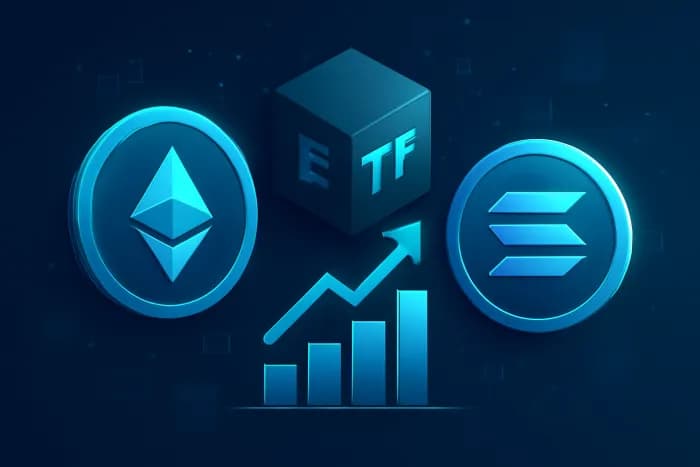Staked ETFs Debut: Grayscale’s ETH & SOL Funds Now Pay Yield

Title: Staked ETFs Debut: Grayscale’s ETH & SOL Funds Now Pay Yield
Introduction As yields in traditional markets hover near historic lows, institutional and retail crypto investors alike are seeking new ways to generate protocol-native income. On October 6, 2025, Grayscale Investments answered that demand by converting its spot Ethereum and Solana funds into yield-bearing ETFs, enabling shareholders to earn staking rewards—without running nodes or managing private keys. In this post, we explore the mechanics, fees, tax treatment, competitive response, and future outlook for these landmark products.
Grayscale’s Staking ETFs Debut for Yield-Seeking Investors
Grayscale’s update applies to three flagship vehicles:
- Grayscale Ethereum Trust (Ticker: ETHE) and Ethereum Mini Trust (Ticker: ETH), now the first U.S.-listed spot ETFs to enable on-chain ETH staking.
- Grayscale Solana Trust (OTCQX: GSOL), which has activated SOL staking and is slated to uplist as an ETF, offering a new brokerage path to Solana rewards. Together, they manage over $8.25 billion AUM and represent a significant shift toward income-generating crypto allocations in mainstream portfolios.
Mechanics of Yield Distribution in Grayscale’s Staking ETFs
At the product level, trust holdings of ETH and SOL are routed through custodians and a diversified network of validator providers. On-chain rewards—including newly issued tokens, transaction fees, and MEV for Ethereum—are aggregated by Grayscale and distributed to shareholders:
- ETHE pays ~77% of net staking yields as quarterly cash dividends, retaining 23% for validators and operational costs.
- Ethereum Mini Trust automatically reinvests ~94% of staking yields back into the fund, with a 6% fee for infrastructure and platform services. This dual approach caters to both income-focused investors and those seeking compounding via reinvestment.
Fee Implications and APY Comparisons
Direct staking through liquid protocols typically yields 3%–4% APY on Ethereum and 7%–8% on Solana. Grayscale’s ETFs incur management fees that affect net returns:
- ETHE: 2.5% fee, resulting in an estimated 1.6% effective yield.
- Ethereum Mini Trust: 0.15% fee (waived for six months up to $2 billion AUM), netting ~1.45%.
By contrast, Lido’s stETH offers ~3.0% net on Ethereum, and Marinade Finance delivers ~7.5% on Solana. The trade-off is clear: ease of access through brokerage accounts versus the cost efficiency of direct or liquid staking protocols.
Tax Impact: Integrating Staking Rewards into U.S. Portfolios
Staking rewards are taxed as ordinary income upon receipt under IRS Revenue Ruling 2023-14. Grayscale’s cash distributions will likely be reported on Form 1099-DIV, while reinvested yields embedded in NAV growth may be taxed as non-dividend distributions upon sale. Limited IRS guidance for pooled vehicles means some reporting uncertainty persists. Investors should engage tax professionals in advance of 1099-DA requirements kicking in for 2026.
Competitive Landscape: Bitwise, 21Shares & ARK
Grayscale’s first-mover status has spurred rival filings:
- Bitwise Solana Staking ETF (0.20% fee), filed October 8, 2025.
- 21Shares’ Ethereum ETF (TETH) now integrates staking with a one-year fee waiver, 0.21% ongoing.
- ARK Invest has paused U.S. Ether staking proposals, but accesses Canadian staking ETFs via ARKW and ARKF. Fee competition is likely to intensify, driving down costs for staking-enabled products over the next quarters.
Future Outlook: Bitcoin Yield Strategies in ETFs?
Though Bitcoin’s proof-of-work design precludes on-chain staking, emerging Layer-2 and derivatives strategies could introduce yield-bearing BTC products:
- Coinbase Bitcoin Yield Fund (CBYF) targets 4%–8% via cash-and-carry arbitrage.
- Starknet’s BTCFi wrapped BTC staking with a $100 million STRK incentive. Competition among Ethereum and Solana ETFs reveals a roadmap for Bitcoin: hybrid models combining price exposure with Layer-2 or derivative yield components may arrive pending regulatory clarity.
Conclusion
Grayscale’s launch of yield-bearing ETH and SOL ETFs marks a pivotal moment in crypto’s maturation, bringing protocol-native income into traditional portfolios. As fees compress and competition heats up, investors will need robust analytics to navigate validator risk, concentration, and tax complexity. TokenVitals’ health and risk framework offers data-driven insights on protocol resilience and operational risks, empowering informed decisions in this evolving landscape.